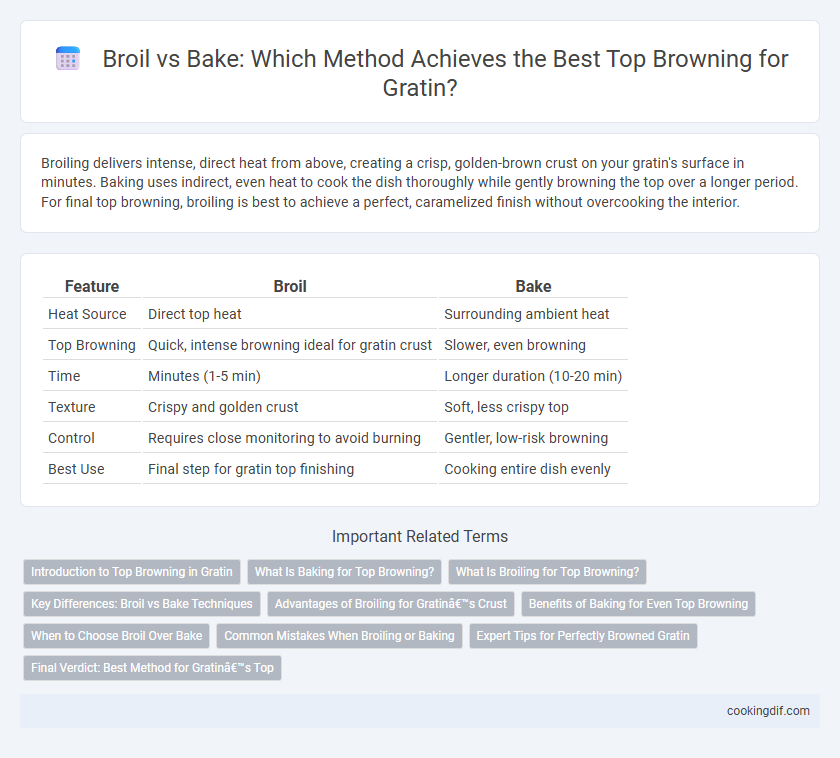Broiling delivers intense, direct heat from above, creating a crisp, golden-brown crust on your gratin's surface in minutes. Baking uses indirect, even heat to cook the dish thoroughly while gently browning the top over a longer period. For final top browning, broiling is best to achieve a perfect, caramelized finish without overcooking the interior.
Table of Comparison
| Feature | Broil | Bake |
|---|---|---|
| Heat Source | Direct top heat | Surrounding ambient heat |
| Top Browning | Quick, intense browning ideal for gratin crust | Slower, even browning |
| Time | Minutes (1-5 min) | Longer duration (10-20 min) |
| Texture | Crispy and golden crust | Soft, less crispy top |
| Control | Requires close monitoring to avoid burning | Gentler, low-risk browning |
| Best Use | Final step for gratin top finishing | Cooking entire dish evenly |
Introduction to Top Browning in Gratin
Top browning in gratin is crucial for achieving a crispy, golden crust that enhances both texture and flavor. Broiling exposes the gratin to direct high heat from above, quickly caramelizing the surface and creating an appealing, toasted finish. Baking, by contrast, uses surrounding heat to cook the dish evenly but may require longer times or increased oven temperatures to achieve similar browning effects.
What Is Baking for Top Browning?
Baking for top browning involves applying consistent, moderate heat throughout an oven, allowing the surface of dishes like gratin to develop a golden, evenly cooked crust. This method leverages radiant heat from both the oven walls and air circulation to melt cheese and caramelize sugars, creating a rich, savory finish without burning. Compared to broiling, baking provides controlled browning by maintaining a steady temperature, ensuring that the gratin's interior cooks thoroughly while achieving the desired crispy, browned topping.
What Is Broiling for Top Browning?
Broiling uses intense, direct heat from above to rapidly brown the top layer of a gratin, creating a crisp, golden crust. This high-temperature method focuses heat close to the food's surface, caramelizing cheese and breadcrumbs quickly without overcooking the ingredients underneath. Ideal for finishing dishes, broiling enhances texture and visual appeal by producing a perfectly toasted top.
Key Differences: Broil vs Bake Techniques
Broil uses intense, direct heat from above, creating a quick, crispy, and browned top layer ideal for gratin's final finish. Bake employs gradual, even heat surrounding the dish, allowing thorough cooking and gentle browning beneath the surface. Choosing broil for the final step enhances gratin's texture with a golden, caramelized crust, while baking ensures creamy, fully cooked layers.
Advantages of Broiling for Gratin’s Crust
Broiling offers intense, direct heat that creates a perfectly crispy and golden crust on a gratin, enhancing both texture and flavor. This method quickly caramelizes the cheese and breadcrumbs without overcooking the interior, preserving the creamy consistency beneath. Using the broiler accelerates browning, delivering an appealingly appetizing finish that baking alone often cannot achieve.
Benefits of Baking for Even Top Browning
Baking ensures consistent, even heat distribution around the gratin, resulting in a uniformly browned, crispy top ideal for achieving the perfect gratin crust. This method allows the cheese and breadcrumbs to melt and crisp gradually without burning, preserving rich flavors and textures. Unlike broiling, baking minimizes the risk of scorching, providing a balanced golden finish throughout the dish.
When to Choose Broil Over Bake
Broil is ideal for final top browning when you need intense, direct heat to quickly crisp the surface without cooking the interior further. Choose broiling for gratins that are fully cooked but require a golden, bubbly crust within minutes. Baking is better for gradual, even cooking, so broil only at the end to achieve that signature gratin finish.
Common Mistakes When Broiling or Baking
Broiling gratin for top browning often results in uneven melting and burnt edges due to excessive direct heat exposure, while baking can produce a uniformly cooked dish but may lack the desired crispy top if not finished properly. Common mistakes include placing the gratin too close to the broiler, causing rapid burning, or not using a high enough oven rack during baking to achieve optimal browning. To avoid these pitfalls, monitor the gratin closely when broiling and use a combination of baking then brief broiling to balance thorough cooking with a golden crust.
Expert Tips for Perfectly Browned Gratin
Broiling your gratin during the final minutes of cooking creates a golden, crispy top layer by exposing it to intense, direct heat, ideal for achieving optimal browning without overcooking the interior. Baking at a moderate temperature ensures even cooking throughout but may not produce the same level of caramelization on the gratin's surface. Expert chefs recommend switching to broil for the last 2-3 minutes to get a perfectly browned crust while maintaining the creamy texture beneath.
Final Verdict: Best Method for Gratin’s Top
Broiling achieves faster, more intense top browning for gratins by exposing the surface directly to high heat, creating a crisp, golden crust. Baking offers even cooking throughout but may result in a less pronounced browned topping when compared to broiling. For the best gratin top, broiling briefly at the end ensures optimal caramelization and texture without overcooking the dish.
Broil vs Bake for final top browning Infographic

 cookingdif.com
cookingdif.com